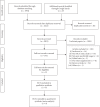The Impact of Natural Product Dietary Supplements on Patients with Gout: A Systematic Review and Meta-Analysis of Randomized Controlled Trials
- PMID: 32047527
- PMCID: PMC7003261
- DOI: 10.1155/2020/7976130
The Impact of Natural Product Dietary Supplements on Patients with Gout: A Systematic Review and Meta-Analysis of Randomized Controlled Trials
Abstract
Natural product dietary supplements (NPDS) are frequently used for the treatment of gout, but reliable efficacy and safety data are generally lacking or not well organized to guide clinical decision making. This review aims to explore the impacts of NPDS for patients with gout. An electronic literature search was conducted to retrieve data published in English language from databases from inception to August 14, 2019. Randomized controlled trials (RCTs) that compared NPDS with or without placebo, diet modification, conventional pharmaceutics, or the other Chinese medicine treatment for gout patients were included. Two authors screened the articles, extracted the data, and assessed the risk of bias of each included trial independently. Meta-analysis was performed using Review Manager version 5.3.5. Results. Nine RCTS were enrolled in this review. The methodological quality of the nine RCTs was poor. The study results showed that in the majority of trials, NPDS demonstrated some degree of therapeutic efficacy for joint swelling, pain, and activity limitation. In contradistinction, serum uric acid (SUA) level (SMD -1.80, 95% CI: -4.45 to 0.86) (p > 0.05) and CRP levels (N = 232; SMD, -0.26; 95% CI, -0.55 to 0.04) (p > 0.05) did not improve significantly. The incidence of adverse events (AEs) was not lower in the participants treated with NPDS (N = 750; RR, 0.47; 95% CI, 0.20-1.11) (p > 0.05). Conclusion. Current existing evidence is not sufficient to provide clinical guidance regarding the efficacy and safety of NPDS as a treatment for gout due to poor trial quality and lack of standardized evaluation criteria. Larger and more rigorously designed RCTs are needed in the future.
Copyright © 2020 Juan Yang et al.
Conflict of interest statement
The authors declare that they have no conflicts of interest.
Figures
Similar articles
-
Cochrane Review: Osmotic and stimulant laxatives for the management of childhood constipation (Review).Evid Based Child Health. 2013 Jan;8(1):57-109. doi: 10.1002/ebch.1893. Evid Based Child Health. 2013. PMID: 23878124 Review.
-
Clinical effectiveness of Tui Na for insomnia compared with estazolam: A systematic review and meta-analysis of randomized controlled trials.Complement Ther Med. 2019 Dec;47:102186. doi: 10.1016/j.ctim.2019.08.020. Epub 2019 Oct 22. Complement Ther Med. 2019. PMID: 31779989
-
Adjuvant therapy with antidepressants for the management of inflammatory bowel disease.Cochrane Database Syst Rev. 2019 Apr 12;4(4):CD012680. doi: 10.1002/14651858.CD012680.pub2. Cochrane Database Syst Rev. 2019. PMID: 30977111 Free PMC article.
-
Antibiotics for induction and maintenance of remission in Crohn's disease.Cochrane Database Syst Rev. 2019 Feb 7;2(2):CD012730. doi: 10.1002/14651858.CD012730.pub2. Cochrane Database Syst Rev. 2019. PMID: 30731030 Free PMC article.
-
Corticosteroid or Nonsteroidal Antiinflammatory Drugs for the Treatment of Acute Gout: A Systematic Review of Randomized Controlled Trials.J Rheumatol. 2018 Jan;45(1):128-136. doi: 10.3899/jrheum.170137. Epub 2017 Aug 1. J Rheumatol. 2018. PMID: 28765243
Cited by
-
Dietary supplements for chronic gout.Cochrane Database Syst Rev. 2021 Nov 12;11(11):CD010156. doi: 10.1002/14651858.CD010156.pub3. Cochrane Database Syst Rev. 2021. PMID: 34767649 Free PMC article.
-
Persistent Purine Metabolic Abnormality Induces the Aggravation of Visceral Inflammation and Intestinal Microbiota Dysbiosis in Magang Goose.Front Vet Sci. 2021 Sep 6;8:737160. doi: 10.3389/fvets.2021.737160. eCollection 2021. Front Vet Sci. 2021. PMID: 34552978 Free PMC article.
References
-
- Khanna P. P., Nuki G., Bardin T., et al. Tophi and frequent gout flares are associated with impairments to quality of life, productivity, and increased healthcare resource use: results from a cross-sectional survey. Health and Quality of Life Outcomes. 2012;10(1):p. 117. doi: 10.1186/1477-7525-10-117. - DOI - PMC - PubMed
Publication types
LinkOut - more resources
Full Text Sources
Research Materials
Miscellaneous






